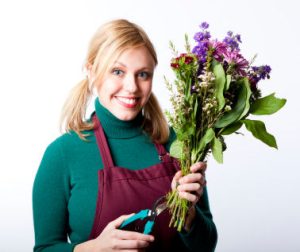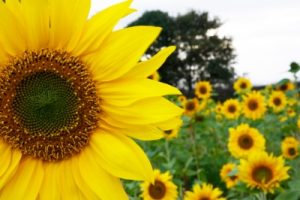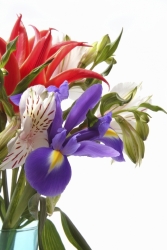![]() Prices in Canadian Dollars.
Prices in Canadian Dollars.![]() Prefer to call and speak to a floral agent? 1-877-277-4787
Prefer to call and speak to a floral agent? 1-877-277-4787
Flowers for Fresh Cutting
Flowers for Fresh Cutting
It is well worth the trouble to grow some spring Flowering perennials or bulbs, sunflowers, baby’s breath for mid summer, and some late Flowering kale, or statice. They make wonderful fresh cut bouquets in your home. Many of these flowers will also be useful for drying.
Fresh Flowers require special handling. We want to preserve the most life and freshness in the plants for your enjoyment.
Picking
Pick Flowers in early morning or late evening when their latent temperature is low. Keep the Flowers cool. Imagine that they are as fragile, tender and prone to wilting as fresh lettuce, and handle accordingly. You can put the cut Flowers in a bucket of water beside you as you work. Try to keep them shaded while they’re waiting for you to finish. It’s also possible to just lay them in a box or wheel barrow, and re-cut the stems when you’re finished and then put them all in water. This would depend on the temperature when you’re picking and how long you will be leaving them out of water. It can also be helpful to cut the stems twice right away, then put them in water.
It is almost always better to make up the bundles as you pick. Don’t pick bulk and expect to handle the Flowers again later to make bundles. Usually you align the heads and clean some of the bottom leaves off, cut the stems to a uniform length, and secure with a rubber band. Don’t make the rubber band so tight that you restrict water uptake.
Plants use water at a surprisingly rapid rate during normal sunny days. The roots actively draw water out of the soil while the leaves are transpiring water vapor into the air.
The plant is just a conduit for all this water, keeping only about 2% for its metabolism. On a sunny day, when the plant is transpiring actively, the water in the rigid xylem tubes inside the stem, is under tension. The roots are not drawing water in as fast as the leaves are transpiring and so the water column inside the plant is actually stretched, in the same way that hydraulics comp ress water.
ress water.
When you cut the stem away from the roots, the tension in the water column is released like a spring, or a rubber band, and the water column “boings” up into stem, leaving behind an air space. On a hot day, with a large plant like a sunflower, this air space can be large. Smaller plants, picked on a rainy day, in the evening, or at cool temperatures will develop a smaller air bubble.
If you put that cut stem as is into a bucket of water, even right after cutting, the air space remains in the xylem tube, and travels up the stem with water above and below it. When the air bubble reaches the head of the Flower, there is an interruption of water available to the Flower and the head will tip over and wilt. This is what happens to roses when they’re not handled properly. The air bubble can also interfere with the flow of water up the stem, all the while it is traveling up, before it reaches the head.
To prevent this problem, you need to re-cut the stem to remove the air bubble. If you hold the bottom of the stem under water, put your shears under water, and cut a few more inches off the bottom of the stem, you can cut away the air bubble. If there is any tension in water column in the stem so that it “boings” again when you cut it this time, it will draw water instead of air into the cut end. This way you’ll have a continuous column of water, with no interruption of flow to the Flower head.
If the plant is cool, and transpiring slowly, you can sometimes, just re-cut the stem, not in water. This will remove the first, large air space and the bubble you just created by re-cutting will be small enough to be not a problem. Usually 2 or 3 inches of stem is removed, except on very large Flowers like sunflowers where 6 inches may be more appropriate. Keep this re-cutting in mind when you decide how tall to cut your stems in the garden. Leave some extra length for repeated cuttings.
Storage
Use clean, fresh water with some floral preservative for best results. The water should be changed daily. The xylem tubes transporting water up the stems can become plugged with plant sap, fungal spores and bacteria, even in what appears to be clean water. The tubes have sieve plates across them at regular intervals up the stem. The little holes in the plates get plugged up with fungal spores and bacteria. You need to re-cut the stems every day or every second day to assure good water movement up the stem.
Remove lower leaves and side stems so that only clean stems are in the water. This reduces the amount of bacteria and fungi that can grow in the container. Damage to the stems will create sites where bacteria and fungi can grow, living on the broken plant cells and sap, and invading the plant to do more damage.
Acclimatization
The plants need to adjust to the changed environment, from a rapidly growing state outside in the garden, to a slowly developing state in your home. If we take a Flower straight from the field, to the florist’s cooler, and then straight to the customer’s home, without any acclimatising period, there is a strong possibility that the plant will wilt, petals will fall, leaves will yellow, and the customer will complain. A properly handled Flower, however, can survive up to two weeks in the home, continuing to develop slowly over the whole period.
The plant loses its roots, some leaves, and experiences water and light stress after it is cut. Even handling and shaking the plants will create a biochemical stress reaction in the plant. In order to preserve the life in the plant we need to slow down its metabolism, making it adjust to a slower water uptake (without roots), lower light, and lower temperatures. Plants, fortunately are very adaptable and can make this adjustment over time.
Flowers picked during a slow part of their daily cycle will have a head start on this acclimatization process. They are already working at a slower metabolic rate. You need to hold the Flowers in a shady, cool place, with the stems properly cut. The plant will be able to respond to lower water demands because of the lower light and cooler temperatures. If the Flowers wilt in the first few hours, you can re-cut the stems and many of them will revive.
Annual Flowers
Amaranthus caudatus. Love Lies Bleeding. Transplants. Could try direct seeding in warmer areas. Harvest trailing red blooms when fully mature. Stems are short. 5 – 7 stems/bundle. See Annuals and Perennials for Drying. Try also upright varieties of Amaranthus. The upright, burgundy type is a good seller.
Cabbage and Kale – Ornamental. Very good for late fall novelty plants and restaurant specialty vegetables. Ornamental Kale is edible, ornamental cabbage is not edible therefore Kale is recommended over cabbage because of its multiple uses. Cut the whole stem as long as possible and keep in water like a large Flower. These must be sprayed early at least twice during season with Bacillus thuringensis toxin for cabbage worms. You can find this at garden centres under the trade name Dipel.
Carthamus. SafFlower. Direct seed early in the season. Plant the large seeds fairly deeply in the soil. Good as a fresh cut, with green leaves and Flower buds, with or without the colored petals showing. You can cut whole, tall stems with side branches to give a tall bundle of 3 – 5 stems, or break off side shoots to get a shorter bundle of 15 stems with the tops lined up. Use only ornamental types with round leaves, and no prickles. The field crop varieties have prickly leaves and are way too hard to handle either fresh or dried. Picked green, safflower is a very good dried Flower.
Cosmos. Direct seed. Will self sow, but 2nd year will give mostly pink Flowers because of cross pollination. Can be fall seeded and try repeat sowings. Try all the new varieties of colors including picotee and curled petals. Pick often to increase yield. Pick long stems, 12″ or more with side buds, in bundles of about 25 stems.
Gypsophila – Baby’s Breath. Try Pink – rosea and Covent Garden types. Good as fresh but do not dry well. Direct seed. Can be repeat planted for longer harvest period. Try growing them in full sun, a bit on the dry side to make the stems sturdier. Tends to be too soft to keep in water for very long. Ten or more stems to make a bundle l0 – 12 inches across at the tops. Helianthus – SunFlower. Try new colored varieties as well as standard golden large and small Flowered types. Best types are: Large to medium size yellow petals around a dark brown centre (Hallo or Halloween), standard large and medium yellow sunflowers, lemon yellow smaller size, teddy bear and sungold, double Flowered types, then Festival, colored types. Sunflowers
Helianthus – SunFlower. Try new colored varieties as well as standard golden large and small Flowered types. Best types are: Large to medium size yellow petals around a dark brown centre (Hallo or Halloween), standard large and medium yellow sunflowers, lemon yellow smaller size, teddy bear and sungold, double Flowered types, then Festival, colored types. Sunflowers
Try fall planting, then repeat seeding every week from April to late July, to extend harvest period. A selection of different varieties will also expand harvest period. Plant seeds fairly deeply to prevent seedlings from drying out.
Sunflowers are heavy feeders and will use a lot of water and nutrients. Be sure to plant in rich soil, and one fertilizer treatment mid season, could be helpful. Don’t replant sunflowers in the same spot next year to reduce disease problems. Be sure to add fertilizer to the sunflower bed before planting anything else, as the sunflowers will have depleted the phosphorus and potassium.
Sunflowers may need watering to prevent wilting on hot days in early spring. Serious wilting will delay blooming and reduce the number of Flowers.
Cut individual stems about 30″ long if possible. Sometimes you can get side shoots to produce smaller, but very nice Flowers from the remainder of the main stem. Smaller varieties should be bundled for easier handling. Cut Flowers when petals are still small, and not expanded. Cut off, (don’t break) the 2 – 3 lowest leaves. Re-cut stems under water at least 4 inches, and more for large types.
Sunflowers are quick to wilt after cutting, but can be revived by re-cutting. They are sensitive to rough handling and will wilt if shaken up too much. Full seed heads with no seeds missing can be used for ornamental purposes. Older Teddy Bears and Sungolds may still be good for drying. Other varieties do not dry well.
Helianthus – sunFlower – Hallo or Halloween. These are most similar to the varieties sold commercially, grown in California and Holland. They have proportionately very large dark brown or black centre with a fringe of medium sized gold yellow petals around the edge. They may be good for drying if picked at an immature stage.
Helianthus. SunFlowers – Teddy Bear. Teddy Bears are dwarf plants with double Flowered heads and no centres, just petals all the way across. Cut short stems early in the season. The side shoots will develop into longer stems. You can also cut the whole stem to give one large mature central Flower and several immature side shoots. Teddy Bears are very nice as fresh Flowers and very good for drying.
Helianthus – sunFlowers – SunGold. These are double Flowered like the Teddy Bears but have a fringe of larger petals around the outside edge. They are full size, tall sunflowers and should be handled like the standard types. Very good for fresh and good for drying.
Helichrysum – StrawFlowers. Use large, healthy and vigorously growing transplants, don’t try to direct seed. Choose Pink, coral, white, red, and only a bit of yellow. Packages of mixed color seed usually have too much yellow so buy seed in separate colors. Don’t grow dwarf varieties, they’re too short. Pick stems about 8 – 12″ long with multiple blooms, strip off some of the bottom leaves and put 12 – 15 stems together in a bundle. StrawFlowers are very good for drying.
Larkspur. Delphinium consolida. Direct seed as early as possible, early April, or as soon as you can get into the garden. Fall planting works too, but plant seed a little more densely to make up for the ones that don’t survive the winter. Larkspur needs cold temperatures and about a month to germinate. It can’t be started ahead for transplanting and it won’t do well if planted too late in May.
For fresh Flowers cut long stems before buds are fully open to the end. Make bundles of 15 long stems of one color, tied with a rubber band. Sometimes you can get a second cut from the side shoots that develop later and these short stems are still useful as dried Flowers. Keep fresh cut bundles cool. Very good for drying.
Stocks. Direct seed very early or use transplants. Don’t use Evening Scented Stocks, this is a different plant with small Flowers. Use instead double Flowered, commercial varieties, greenhouse types are OK, sometimes called 10 weeks stocks. Any color is good. For fresh cuts, pick before buds are open all the way to the end. For drying wait until all the Flowers are open to the tip. Ten – 12 stems/bundle not less than 10″ long.
Statice. Limonium. Annual statice. Use large transplants for better yield. Plant on 12 – 18″ centers to crowd out weeds between plants. Sensitive to early spring and late summer frosts, so some frost protection is best.
Buy seed by color. Most mixed packages have too much purple and yellow and not enough pink. The most popular colors in order of preference, pink, peach, light blue, white, light mauve, dark purple, yellow last. The intense color of statice is produced, not by the petals, but by the calyx surrounding the Flowers. This is the same as the green leafy structure around the base of the sunflowers, or the back of a daisy.
The true statice Flower is the small pink or white, short lived bloom that shows in the centre of the Flowers. The bright colored calyx is much sturdier and will maintain its color and shape for weeks when fresh, and forever when dried. This growth pattern is followed by all the members of the statice family including German statice, Caspia and Latifolia.
Pick when all the calyxes are fully developed all the way to the tips of the Flowering stems. Mature stems will snap off easily at the base. Immature stems will bend, not snap. You can put 10 or 12 full length stems together to get a tall thin bundle. Try also breaking off 1 or 2 of the lowest side shoots, align tops with main stems and put 15 total in a bundle. This gives a shorter but fuller looking bundle. Best quality will have lots of color.
Statice suworowii. Rattail statice. Pink Poker. Russian Statice. Use transplants. Easy to grow. Pick when in full color with branched stems. 10 – 12 stems/bundle.
Perenial Flowers
Achillea millefolium. Yarrow. Pastel. Very slow from seed. Easier from root divisions of older plants. Choose pastel colors, in lighter shades, Pink, peach, yellow. Approximately 25 stems per bundle with heads aligned in an umbrella shape. Clean leaves off bottom 3″ of stems to keep water clean.
Achillea ptarmica. The Pearl. Bridal Veil. This is a very good plant, looks like large Flowered baby’s breath and dries very well. May be started from seed but easier from root divisions or stem cuttings. Cut stems when Flowers are well open, and bundle loosely in handfuls. It may be necessary to clean some of the leaves off the bottom of the stems. Recommended.
Delphinium. All colors are popular. Look for varieties with the Flowers packed closely together on dense heads. For fresh cuts, harvest before all the Flowers are open to top while there is still about ¼ of the stalk in bud.
Easy from direct seeding in the garden in July for small plants the following year. Will take another year for Flowers. Can be grown from divisions of larger plants, and even rooted stem cuttings from vegetative growth, not Flower stalks.
For fresh cuts pick stalks before the buds are open all the way to the end. For drying wait for all the Flowers to open right to the tip. Handle carefully, this is a fragile bloom. Commercial growers add STS (Silver thiosulfate) to the water, to prevent the petals falling.
Echinops ritro. Globe thistle. Transplants. Will not produce until second year. Very popular. Slow to spread, not a weed problem in Alberta, but may be a problem in Ontario or warmer climates. Pick before small flowerets appear, when heads are bright blue. Choose tall stems, usually 2 – 3 heads per stem, side shoots will be immature. Make bundles of 10 stems with multiple heads.
Eryngium planum. Sea Holly. Direct seed. Can be fall planted. Self sows, so can be a weed problem in some areas. Pick when Flower heads and stems are bright blue. Make bundles of 4 – 5 large stems. Look for new improved varieties including Eryngium giganteum.
Gaillardia. Easy from seed. Full Sun. Can tolerate dry conditions. Try new varieties in fancy colors. Larger sized Flowers more popular. 15 stems per bundle.
Gypsophila paniculata. Baby’s Breath. Single Flowered. Direct seed or transplants. Will not produce heavily until second or third year. Very tolerant of drought, and weed competition.
Pick when most Flowers are fully opened. Three to five large main stems gives one large bundle. Use more smaller stems to make a bundle of equivalent value.
For fresh cuts, snap mature stems at base, roll up bundles with newspaper to make them smaller and put in water immediately. To hold for more than a few hours stems should be re-cut. For drying, bundles should be shaken out to full size before hanging.
Gypsophila paniculata. Baby’s Breath – Double Flowered. Same plant as above, but Flowers are larger. Highly recommended. If you are starting a new planting choose this type over the single Flowered variety. Seeds of double Flowered baby’s breath will produce only about 60% double plants with the remainder single Flowered. Commercial plants are grafted to give uniformly double stands. Very good fresh cut. Same handling as single Flowered.
Iris. Transplants. Likes cool, shade and moist conditions. 3 – 5 years from seed. Pick when buds are still tight, with only a bit of color showing. 10 stems per bundle.
Lupine. Lupinus. Very easy from seed. Requires winter protection in northern Alberta. Individual colors will cross pollinate to give pink only progeny. Any color is good. 10 stems per bundle.
Matricaria. Feverfew. White or Yellow types are good. Easy from seed. Plant in early spring or try fall planting. 15 – 20 stems per bundle. Likes partial shade.
Peony. Peaonia. Very good fresh cut. Cut when still in closed bud stage with some color showing. Long stems 12″ or more with side buds attached. Any color is good, but pinks are the best sellers. Pink is most popular, followed by white and red. You can sometimes get some production from large roots after one year, but usually you need two to three years to get optimum production. Mature plants can have l00 or more blooms. Peonies do well in full sun or partial shade.
Physalis franchetti. Chinese Lantern. Does well in protected location, close to buildings. Vulnerable to late frost just as the lanterns are coloring. Pick mature, orange lanterns on long stems. Leave a bare stem at base for handling. Leaves will wilt quickly so put in water immediately.
Statice capsica. Caspia. Tender Perennial in Alberta. Pick when Flowers open all the way to ends of stems. 5 – 7 full stems per bundle.
Statice latifolia. Similar to Caspia. Same handling.
Statice tatarica. German Statice. Transplants. Takes 2 to 3 years for good yields. Pick when Flowers open all the way to ends of stems. Very slow to mature, August. One three year old plant will yield one standard florist bundle.
Statice – Disease – Aster Yellows Mycoplasma. This disease is common on statice plants, and especially problematic on perennials. Causes stunted, yellow leaves and extremely vertical, upright stems, without normal branching or curving. Spread by insect vectors and mechanical damage and can overwinter on plant debris. Remove affected plants and burn them, and sterilize shovels, pruners, etc. This disease affects a wide range of plants.


